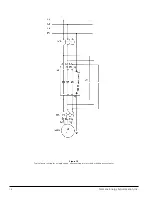
Siemens Energy & Automation, Inc.
9.3 Shorted SCR Checks
Perform one of the following checks to identify any shorted
SCR’s.
These checks require no disassembly of the unit.
Extensive SCR tests are detailed in later paragraphs.
9.3.1 Resistance Check
Use an ohmmeter to check for shorted SCR(s) as follows.
1. Disconnect and lock out all power to unit.
2. Measure the resistance from the line to load terminals (L1
to T1, etc.), across each phase of the controller.
3. Any reading of less than 3,000 ohms indicates a shorted
SCR that must be replaced. Note that the reading can be as
high as 3,000,000 ohms.
9.3.2 Voltage and Load Check
Main and control power are connected to the unit for this check.
To prevent motor operation during testing, disconnect the run
signal at terminals A1 and A2.
1. Measure AC voltage across each pole and check the load cir-
cuit as described in paragraph 6.5, step 5.
2. If voltage measurements indicate a shorted SCR, replace
the SCR.
9.4 Thyristor (SCR) Functional Testing
The following basic and advanced tests may be used to verify
SCR module functionality.
9.4.1 SCR Description
Thyristor description and illustrations are included here to help
identify the terminals for the functional tests.
The power switching device is furnished as an insulated dual
SCR module. The two SCR’s in each module are connected in
inverse parallel (back-to-back). One module, or power pole, in
each line gives bidirectional control of the AC voltage. Typical
connections are shown in figure 15. Each SCR has two inter-
nally connected cathode terminations, a large power cathode
terminal, and a smaller auxiliary cathode terminal or wire for the
control connection.
A forward biased SCR (anode positive, cathode negative) will
turn on and conduct current if positive control voltage is applied
to the gate terminal and gate current flows inside the SCR junc-
tion to the cathode. The SCR turns on and stays on at anode
currents above the latching value. It remains on until anode cur-
rent falls below the holding value.
The module and SCR characteristics listed below are represen-
tative of all modules and SCR’s. The value for each characteris-
tic is a “typical” value.
Illustrations identifying terminals and connections for thyristors
of various current ratings are included at the end of this section.
9.4.2 Test Equipment
The following equipment is used for the functional tests.
1. Portable DC multimeter - volts, ohms, and amperes (analog
type preferred).
2. Insulation tester - 1,000 volt DC megohmmeter (“megger”)
battery operated amp probe AMB-4D or similar.
3. 9-volt battery NEDA 1604.
4. 100-ohm resistor, 1 watt minimum.
5. 20-ohm resistor, 5 watts minimum.
6. Battery clip and clip leads.
Hazardous voltage.
Will cause death or serious injury.
High voltage is present on all controller com-
ponents except heat sinks, current transform-
ers, and the basic control board. All bus bars,
terminals, snubber boards and the SCR’s are
energized at rated voltage. Use established
safety procedures to avoid injury.
Figure 15
- Typical Isolated Power Pole and Power Module
Hazardous voltage.
Will cause death or serious injury.
To avoid electrical shock or burn, discon-
nect and lock out all power sources from
controller before testing.
29






















